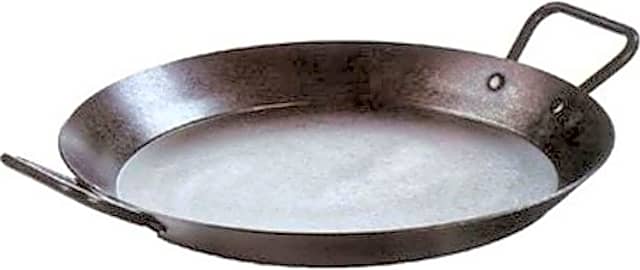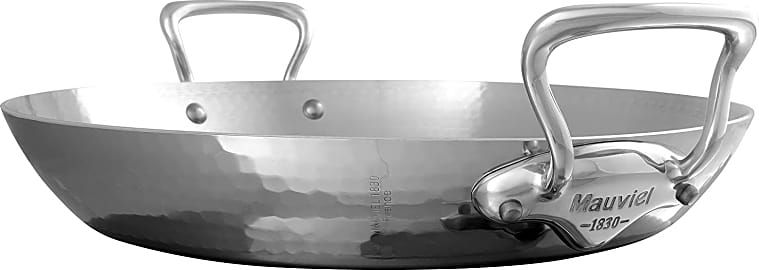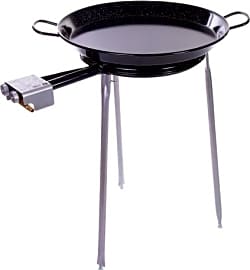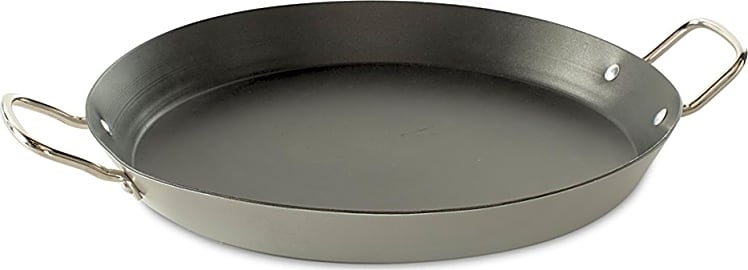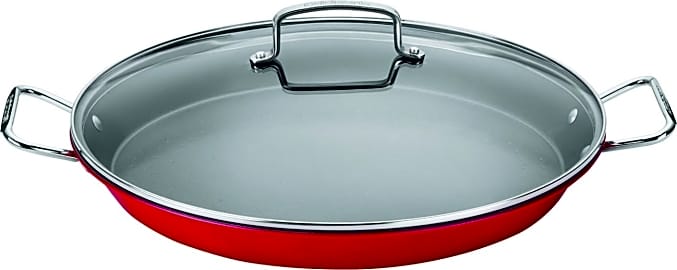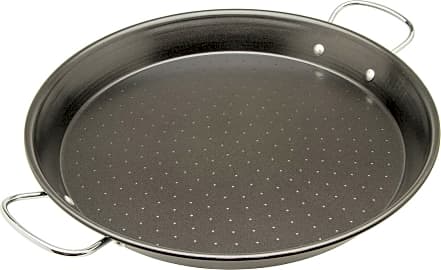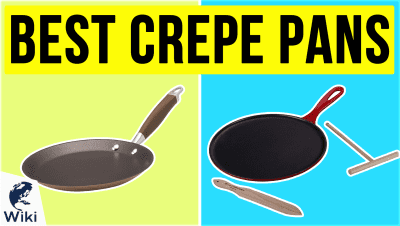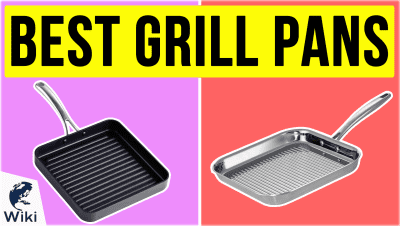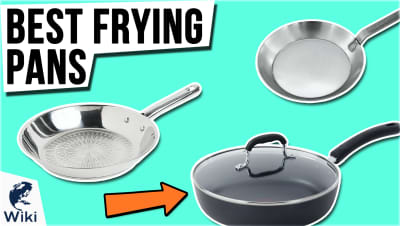The 10 Best Paella Pans

This wiki has been updated 41 times since it was first published in January of 2016. Cook up some rice, throw in whatever suits your fancy and -- Olé! -- you've made paella. Although the traditional Valencian dish calls for beans, tomatoes, chicken, rabbit, snails, and saffron, you can use any ingredients you want. It is easier to prepare in one of these dedicated pans crafted from stainless steel or cast iron with shallow, wide surface areas that conduct heat evenly. When users buy our independently chosen editorial recommendations, we may earn commissions to help fund the Wiki.
Editor's Notes
August 06, 2021:
Sadly, one of our previous favorites from high-end designer Le Creuset is now very hard to find, so we can no longer recommend it for most people. But, never fear, there are plenty of paella pans out there to choose from. For example, the Garcima 26-Inch Carbon Steel is as simple as a large model gets, and the Sertodo Copper Alicante offers an impressive balance of conductivity and food release thanks to its hand-hammered dimpled surface. And because there's not much to these pans overall, you can also get by with something affordable yet well-made like the Imusa 15-Inch.
April 27, 2020:
Paella originally became a popular dish among farmers in Spain and included ingredients readily available to them including rabbit, duck, snails, chicken, rice, tomatoes, and beans. Its identifying feature was a layer of toasted rice cooked on the bottom. Those who prepared the dish preferred large, shallow pans that cooked a lot of food quickly to be shared easily by groups of workers. Like stir fry pans, these are available in a variety of materials including heavy duty cast iron, quick-heating stainless steel, and highly conductive copper. This latter metal is what comprises the newly added Sertodo Copper Alicante, which is made by hand and offers a durability that aims to last for generations. Artisans incorporate an elegant hammer finish and a long-lasting tin finish that allows for easy food release. Its stainless steel handles stay cool to the touch, so you can carry your dinner from the stove to the table with ease. Sold separately from the manufacturer are matching pieces like Moscow Mule mugs, water pitchers, plates, and more. The paella pan is available in 12-, 15-, and 18-inch sizes, so you’re sure to find a size that suits your household.
We kept the Garcima 26-Inch Carbon Steel in its top spot in this update. Made in Spain, this authentic piece of cookware features durable carbon steel that conducts heat well, and it’s safe for the stovetop, oven, or grill. Its large size is great for serving up to 20 people, and it comes with a booklet featuring recipes, tips for cooking paella, and care instructions. For another model designed to last over the generations, look to the French-made Le Creuset Enameled, which is made of cast iron and covered in your choice of five striking enameled exterior colors, with a matte black interior. It’s great for producing results with a crunchy, unburnt crust and is even safe to place in the freezer.
Anyone interested in a model that utilizes the traditional wood fire method used in Spain should check out the Castevia Stand Set, in which the pan is situated atop a stand and attached to a gas burner, making for easy outdoor use. It’s made to be attached to a standard propane tank and stands freely. It can serve up to 13 people at a time. The Mauviel M'Elite is a bit of an investment, yet it’s hard to beat when it comes to evenly cooking foods on any stovetop – including induction – as well as in the oven and under the broiler. It’s made by hand in France and comes with a money-back satisfaction guarantee, so you can purchase it with confidence.
A Brief History Of Paella
They used a large, shallow vessel capable of cooking an ample amount of food quickly, and workers consumed it straight from the pan with their own wooden spoons.
Paella is traceable to the 1800s, however, its origins stretch much further into the past. When Moorish armies traveled from Northern Africa to conquer the Iberian Peninsula in the 8th century, Valencia was one of many regions that fell under their rule. Located on the coast of the Balearic Sea, Valencia boasts flat terrain rife with freshwater rivers and lagoons. Once they arrived, it didn't take long for the Moors to recognize the value of these natural wetlands and transform them into rice paddies.
After centuries of Moorish influence, rice became firmly established in Spanish cuisine. Cooks would combine it with vegetables, various spices, and fish to create sumptuous communal meals devoured at family gatherings and religious ceremonies. During the 1700s, Valencians would gather to cook rice in the open air for special celebrations. They accented these early versions of paella with butter beans, eels, and the meat of water voles, which were plentiful and easily caught.
Paella as we know it was initially prepared by farmers who would congregate during the workday to share a meal. They used a large, shallow vessel capable of cooking an ample amount of food quickly, and workers consumed it straight from the pan with their own wooden spoons. As living standards improved, so did the ingredients of this rustic dish. Rabbit, duck, snails, and chicken replaced water voles, while beans and tomatoes were culled from bountiful neighboring gardens. A chef would roast his meal over wood from nearby citrus groves, and additions such as saffron, rosemary, and thyme were vital for perfecting the flavor.
People also found they had more free time, and as such, they had ample reason to enjoy leisurely courses together. Paella migrated from the fields to the homes and backyards of many locals, and it became a staple throughout the region. It was so popular that local newspapers began reporting on it, and one such publication referred to the recipe by the name of the pan it was cooked in — paella.
The dish eventually crept outside of Valencia into the rest of Spain, where other Spaniards would substitute whatever meat was regionally available in lieu of holding fast to the traditional ingredients. With the rise of tourism during the late 1900s, the dish obtained a reputation as a hallmark of Spanish cuisine.
What To Look For In A Paella Pan
Paella pans offer a clever structure that, above anything else, is conducive to cooking the famed Valencian dish of the same name. They boast two vital features: a large surface area that's shallow and wide, and a metal construction that conducts heat evenly. These attributes enable the various oils and liquids the recipe calls for to evaporate rapidly, and they allow the rice to form its characteristic caramelized crust.
This means you’ll need a product with strong riveted handles that stay cool to the touch so you can handle and transport the vessel safely.
Paella pans crafted from carbon steel, cast iron, and stainless steel tend to be favorites among chefs and home cooks. Cast iron and carbon steel are relatively similar — each material is tough enough to last a lifetime and offers excellent heat distribution and versatility. That being said, they require a bit of extra care to prevent them from rusting, and they need proper seasoning in order to take on non-stick qualities. Cast iron, in particular, is very heavy, so heaving it to and fro may become tiresome. If you want to go the traditional route, consider a Spanish-made carbon steel paellera that boasts a dimpled surface.
Another important factor is the size of your pan. If you’re rustling up dinner for your immediate family or a few friends, a model with a 16-inch diameter is ideal, as it can feed up to six people. Those attempting to satiate an army of eaters will want something closer to 26 inches, which will be able to satisfy around 20 hungry mouths. Don’t fret if your pan is so large that it hangs over the edge of the heat source you’re utilizing — as long as you’ve selected one that’s made from a quality conductive material and you practice proper preparation methods, everything should cook evenly.
You should prepare paella outdoors over an open fire or grill and serve it straight from the pan. This means you’ll need a product with strong riveted handles that stay cool to the touch so you can handle and transport the vessel safely.
Tips For Making Perfect Paella
When preparing paella, there are a few tips that can aid you in your endeavor to produce a standing ovation-worthy dish. Before you begin, chop, peel, and clean your ingredients. Portion them out and place them in bowls or small ramekins, so you don’t have to worry about measuring as you go. A few simple minutes of prep before you turn on the heat will keep your stress levels down and allow you to enjoy the process, all while minimizing mistakes.
One of the most difficult aspects of attempting this meal is resisting the urge to stir it.
One of the most difficult aspects of attempting this meal is resisting the urge to stir it. It’s actually best to refrain from doing so, as you’ll prevent the delectable golden socarrat from forming on the bottom. Instead, rotate the pan as needed. This is especially helpful if you’re cooking over an open flame that has alternating cold spots.
When it comes to the rice, don’t shortchange yourself by buying whatever is cheap at the grocery store. Short grain Bomba rice is highly absorptive and will soak up all the flavor of the stock you add. Plus, it’s what the Spaniards use, so you’ll be safe from scorn if there are any purists at the table.
Be sure to brown your meat thoroughly, and don’t hold back in fear of burning it. You’ll want your protein to have a crispy skin, but not be completely cooked, as it still needs to be boiled in broth. For your stock, be generous with the salt, otherwise you’ll end up with bland rice. A good rule of thumb is to taste your dish at every stage of cooking to be sure things are on track.
It can be intimidating to tackle paella, but if you arm yourself with the proper pan, fresh ingredients, and a dash of patience, you’ll be rewarded with a delectable and addicting meal.




